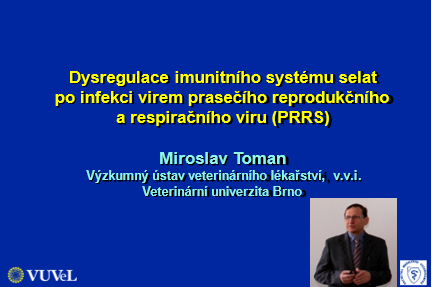Porcine reproductive and respiratory syndrome (PRRS) is a viral disease affecting various categories of pigs. Although the clinical signs of infection vary depending on the immune status of the animals and the virulence of the strain, PRRS primarily manifests as reproductive impairment in sows and as respiratory disease in pigs of all age groups. The disease is associated with direct and indirect economic losses. Even without the development of clinical signs, the virus is capable of infecting the thymus and affecting the development of T-lymphocytes, particularly in newborn piglets.
To prevent the disease, several vaccines are available; both live attenuated and inactivated types. In herds where the disease has been eradicated, i.e. PRRS-free herds (most herds in the Czech Republic are PRRS-free), either no vaccination is carried out or only inactivated vaccines are used. Nevertheless, there are farms that use live attenuated vaccines.
The topic of the disease's immunopathogenesis and vaccination was addressed in the project of the National Agency for Agricultural Research QJ1210120 "A programme to control economically important infections in pig herds" in collaboration between the VRI and VETUNI and in the project of the Grant Agency of the Czech Republic 20-03282S “Porcine reproductive and respiratory syndrome virus (PRRSV) alters thymocyte development and repertoire of T lymphocytes“ in collaboration between the VRI and the laboratory of gnotobiology of the Institute of Microbiology of the Czech Academy of Sciences.
Experiments conducted under these projects have shown that viral strains used to produce live attenuated vaccines induce similar changes in the thymus as field viruses. For these reasons, the suitability of immunizing piglets with live vaccines must be considered carefully. Prof. Miroslav Toman, CSc. addressed this topic in his lecture on 6 June 2024 at the Institute of Microbiology of the Czech Academy of Sciences, as part of the regular seminars hosted by the Czech Immunological Society.


